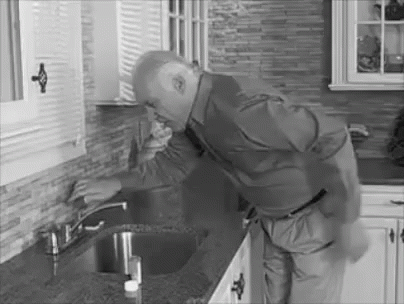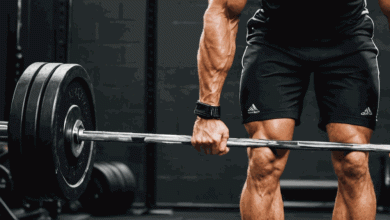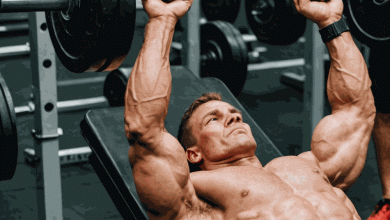How to Do Kettlebell Swings
We may earn money or products from the companies mentioned in this post.
Kettlebell swings are an amazing workout. However, if you don’t know what to do, you can really hurt yourself.

Also, I have no idea what this could have been an infomercial for…
Anyway, we’ll look to help with this guide on how to do kettlebell swings.
Easy Navigation
What You Should Not Do
Understanding the potential mistakes that you can make is a great way to ensure that you take proper steps and prevent injury. The kettlebell swing looks like a simple enough exercise, but it can become ineffective or dangerous if done incorrectly.
First, this is not a squat movement. Therefore, there should never be too much bend in the knees. The drive and explosion should always come from your hips and your legs. When you go into a squat, you transition into an up and down movement. Remember that the kettlebell swing is supposed to be a thrust.
Next, you always want to avoid swinging too low. If you’re doing the kettlebell swing correctly, it should touch or come close to your glutes. Your arms are not supposed to be falling between your knees. Of course, it is not an upper-body workout, but you still do need a firm enough grip to prevent the weight from dipping too low.
Finally, do not lean back at the top position. In fact, if you experience pain that is specifically related to your kettlebell swing, you are doing something wrong. Keep your core tight and hinge at the hips.
The Form and Flow – How to Do Kettlebell Swings
The start position requires you to place both feet just outside of shoulder-width apart. Hold your kettlebell in front of you. Both arms are supposed to be straight.
Next, keep your back flat, slightly bend your knees, and hinge at your hips as you swing the kettlebell between your legs. The next step is to do a forward hip thrust as you engage your glutes to stand straight.
This is one fluid motion. So, the momentum of the swing should be used during the standing phase. This allows you to swing the kettlebell all the way up to shoulder height. Remember that your core should be engaged throughout the entire movement.
By the time the kettlebell gets to your shoulder height, your glutes should be completely contracted, and there should no longer be a bend in your knees. You have completed your first rep when the kettlebell reaches between your legs again.
You must never forget that you are doing a hip hinge. It’s best to practice the motion with no kettlebell first. This allows you to master the movement and to get comfortable with the flow. During this time, you can identify if you are making any of the mistakes discussed above.
Remember to never round your back and to keep your core tight throughout the entire movement. You don’t want to use a kettlebell that is so heavy that you can’t even deadlift it. However, you also don’t want a kettlebell that is so light that you could pick it up with a single finger. The one you choose should be heavy enough to provide a challenge and the kind of momentum that you need for the exercise.
Begin with a weight that allows you to do about three sets of five reps. Rest for 15 to 20 seconds between each set. As you become better able to manage the weight, you can use a heavier kettlebell or increase the number of reps you do.
What Are Kettlebell Swings Good For?
The kettlebell swing has numerous benefits for those who are willing to remain consistent in doing it. First, it works many different muscles simultaneously. These include the pecs, shoulders, hamstrings, lats, abs, hips, and glutes. Additionally, it is a great way to improve your grip strength.
The fat-burning potential is another one of the top reasons for you to learn how to do kettlebell swings. You may not think much of the exercise initially. However, as you start extending your workouts, the intensity translates to your burning many calories. The great thing about this is that you get the benefit of improving and maintaining your muscle mass as you lose unwanted body fat.
As far as cardio goes, the kettlebell swing is more efficient at calorie burn than just about every other traditional type you can think of.
How to Incorporate Kettlebell Swings into Your Workout
You have a lot of creative freedom to decide how you want to implement kettlebell swings into your workout regime. People who already have an existing bodybuilding or weightlifting routine especially need to know this.
Your first option is to do swings on an active recovery day. The point of these days is to ensure that your body is doing something while it recovers from the beating that it took the day before. Of course, the activity should be nothing to send you on a one way trip to soreness. Kettlebell swings allow you to get in the activity you need without breaking your muscles down too much.
Second, any day that is spent doing leg or back workouts is a good day to incorporate your kettlebell swings. The best way to do this is to complete the rest of your workout and use the swings as your finisher. By this time, the energy from carbs in your body should all be used up. Therefore, your body has no choice but to turn to and burn fat as an energy source.
Finally, the kettlebell swing can stand on its own as a complete cardio workout. There is nothing wrong with scheduling a workout that is 30 minutes long or more and completely revolves around kettlebell swings.
Of course, there are other options, such as incorporating them in your warm-up. Nevertheless, the ones mentioned here stand among the most useful.
How Frequently Should Kettlebell Swings be Done?
As is the case with any other workouts, you need to do kettlebell swings enough for it to make a difference. However, you don’t want to overdo it, as you run the risk of reducing its impact on the body.
A good number to shoot for is three or four times a week. Also, it’s a good idea to vary how you use the exercise. So, if you use it as a full cardio workout on one day, you may want to use it as a workout finisher on another day.
Further Reading
Looking for more articles about Kettlebell swings? Check out these articles.
Find the best Kettlebells for a home gym
How heavy a Kettlebell should I use?

